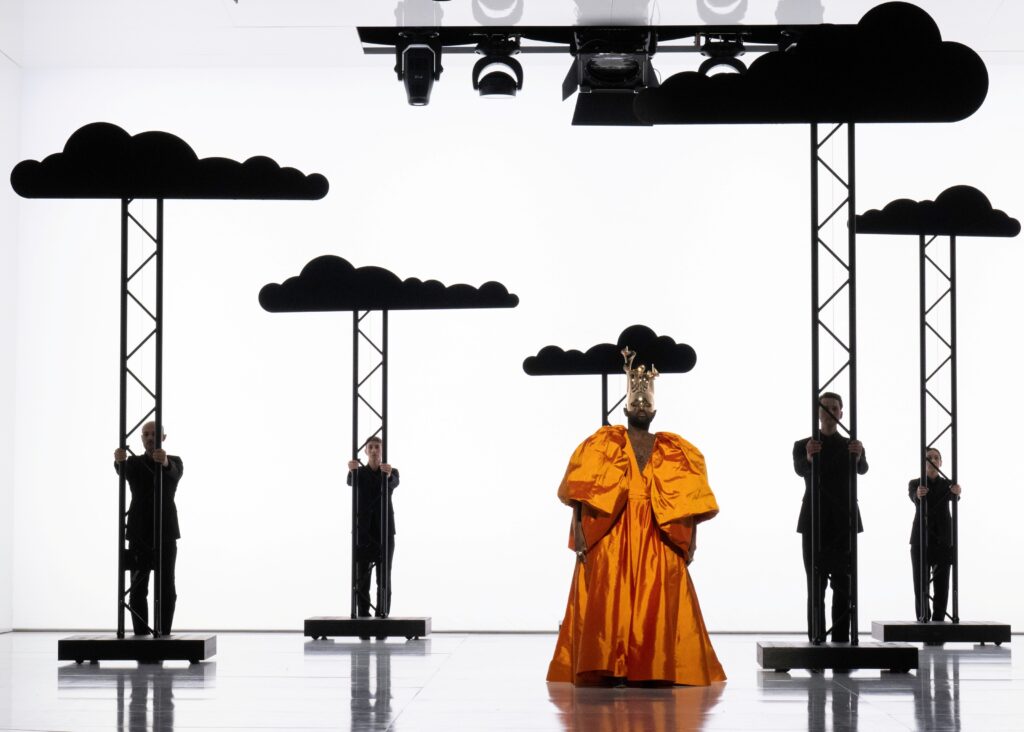Fighting the heretic king: Barrie Kosky devotes himself entirely to the music in his new production of Philip Glass’ ‘Akhnaten’ for the Komische Oper. Jonathan Stockhammer in the pit provides the suitably urgent and pulsating mantra music with a driving beat.
This is not at all how we know the bustling, lively and versatile director from Australia. As head of the Komische Oper for ten years, he was also the innovative driving force behind the theatre and his works usually feature lively ensemble scenes overflowing with ideas.
His interpretation of the Egyptian pharaoh Akhenaten, who shook the foundations of the ancient Egyptian system and failed, and whom Philip Glass placed at the end of his opera trilogy about the powerful and influential men of world history, is now the opposite: the sterile, white and black space that Klaus Grünberg has built on the stage is tidy and uniform. People stand for minutes, then walk again and suddenly gesticulate and dance wildly. Everything is repeated like a prayer wheel from the beginning to the end of the three-act play, making the various developmental phases with the rise and fall of Akhenaten (which Glass also shows in his work) seem incidental.

Whether it is the grand funeral ceremony for the deceased father, the coronation of the son or the dance of death at the end of the legendary pharaoh who set out to turn the Egyptian world upside down by turning away from the religion of Amun in favour of the sun god worship of Aten and thus himself, Kosky always presents a wonderfully detailed choreography with recurring motifs. This is reminiscent of the eternal return of the same, but again Kosky does not pursue it stringently to the end. He is clearly not interested in the motives of the pharaoh, who, in a triangular relationship with his mother Teje and wife Nefertiti, can still be marvelled at in the world’s museums today as an androgynous ruler with an almost female body and narrow facial features.
Why is he fighting against the cult of Amun? Suddenly, Kosky has Akhenaten himself murder the priest (Stefan Cifolelli with a beautifully flowing tenor) at the temple of Amun on stage. It’s a shame that Kosky doesn’t utilise the space that the music and the tableau-like work with its hypnotic pull gives the director. Instead, the IKEA lamps float down from above and we know that the era of the Aton suns has now dawned. Many sentences are faded in, which are still spoken in German by the chronicler (Peter Renz) anyway. This seems redundant.

Whether the inner motives, his transformation and the relationship to his mother and wife (keyword Oedipus): All this would have been interesting and reason enough for the director to find an interpretation. Instead, Kosky fully complies with the oratorio-like style of the work and leaves it at a pure illustration of the play. And in doing so, he devotes himself completely to the music.
This is most evident not only in the programme booklet (Kosky: ‘Actually, the music is the production’), but above all in the sudden illustration of Akhenaten’s fall: John Holiday as Akhenaten in a woman’s dress grows ever longer Rasta hair. However, the joint dance with the people develops into a pogrom – here Kosky is back to his original theme – which shows the end of the ‘heretic king’ drastically and clearly, but completely detached from the context. The popular mob kicks the PoC (Person of Colour) Pharaoh together.

Holiday sings the title role in a nuanced and radiant manner with his marvellously finely flowing and flooding countertenor. The sun anthem in particular is gripping and differentiated. He is supported by Susan Zarrabi as Nefertiti, a mezzo with a warm and dark timbre. Mother Teje is sung by Sarah Brady with the soft intonation of her secure soprano.
Gripping and concise, full of bursting sound power and together with the ensemble of dancers, the choirs (rehearsed by David Cavelius) provide some of the musical highlights of the premiere evening.
Jonathan Stockhammer leads the orchestra without violins through the score, which seems more conventional than ‘Satyagraha’, but is able to offer the listener a lot of interesting things thanks to the many shifts, reverbs and chromatic Akhenaten insertions. Stockhammer works this out vividly and appealingly with driving tempi that only sometimes get a little tangled.
Enthusiastic applause for all involved.